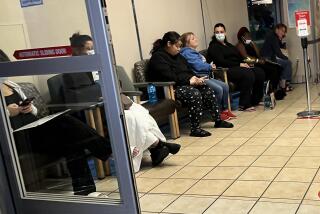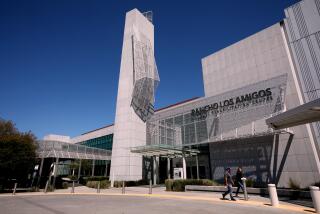Emergency room visits at this Loma Linda hospital are long — really long

- Share via
- Loma Linda University Medical Center ranked third in the country for how long its patients typically spent at the emergency department, with a median time of nearly seven hours, based on federal data.
- Hospital officials said the problem stems from a shortage of health services in San Bernardino County.
When Jesus Garcia got a phone call that his 43-year-old sister might be suffering a stroke, he jumped into the car and hustled to get her to the Loma Linda University Medical Center emergency room.
Then they waited. It took roughly three hours that July night, Garcia said, before they were ushered to a triage area in a hallway, and another three hours passed before they saw a doctor.
Garcia’s experience was all too common, according to federal data. In recent years, patients have typically spent roughly seven hours at the Loma Linda emergency department before leaving, data from the Centers for Medicare & Medicaid Services show.
Loma Linda ranked third in the country for how long its patients typically spent at the emergency department, according to a Times analysis of federal data covering October 2022 through September 2023, the most recent available. The ranking was previously reported in Becker’s Hospital Review.
Federal figures reviewed by The Times show that the length of stay was more than twice the median at other hospitals with high volumes of patients nationwide. Thousands of people left before being seen, the data show.
Loma Linda officials said the long times stem in part from a shortage of healthcare in the growing region. Dr. Adrian Cotton, chief of medical operations at Loma Linda University Health, said gaps in other medical services had resulted in many people coming to the Loma Linda emergency room for care that could have been handled elsewhere.
Emergency departments in the region have grown: The Times analysis found that hospitals across San Bernardino County, where Loma Linda is located, added 44 treatment stations at their emergency departments between 2014 and 2023, a nearly 10% increase.
Yet San Bernardino County hospitals typically had a higher ratio of emergency visits to treatment stations than the California median, according to a 2021 state report covering many of its hospitals, suggesting a greater burden on emergency departments there.
The Inland Empire has the lowest ratio of primary care physicians to population among California regions, according to an analysis three years ago by the California Health Care Foundation. A state report found the region had a disproportionately small share of California physicians.
That has piled more pressure on emergency rooms, Loma Linda hospital officials said, with the numbers of adults coming to the emergency department roughly doubling in the past decade.
“It’s the only place in healthcare where you can’t turn the faucet off,” Cotton said of ERs. “We can’t ever say, ‘Oh, we’re full, we’re going to close.’”
Earlier this year, the hospital was faulted by California regulators over a January incident in which a patient showing signs of a damaged liver ended up leaving the emergency department after spending more than 20 hours there waiting to be admitted.
State investigators found Loma Linda had failed to follow its own rules about how quickly a patient should be assessed for hospital admission after it was requested. Its emergency department director told the investigators that its two-hour goal was “not always attainable” when doctors were busy, the state report said.
Hospital spokesperson Briana Pastorino said any concerns related to the violation had been addressed. “We take such matters seriously and are committed to maintaining the highest standards of care and compliance,” she said in an email.
George Greene, chief executive of the Hospital Assn. of Southern California, said that hospitals across California are grappling with the demand for emergency services, but “in San Bernardino County, the situation is particularly pressing.”
At more than 20,000 square miles, San Bernardino County is the largest by size in California and has some areas with especially stark needs. Seven years ago, a San Bernardino County grand jury report found that a shortage of emergency beds in the high desert — an area that includes Victorville and Adelanto — was leading to overcrowding at emergency departments. One of the closest hospitals with a trauma center was Loma Linda.
Loma Linda opened a new campus three years ago, but if it had the money, “we probably would have built a hospital six times the size — and an ER 20 times the size,” said Dr. Anthony Hilliard, chief executive of Loma Linda University Health.
Yet amid the regional crunch, other emergency departments in San Bernardino County have averaged much shorter stays than Loma Linda, according to federal data. At Arrowhead Regional Medical Center in Colton, for instance, the median length of a visit to the emergency department was half that of a Loma Linda visit.
Loma Linda officials said their medical center has been hit especially hard because local patients gravitate to the hospital. In patient surveys, nearly 80% of those surveyed at Loma Linda said they would definitely recommend the hospital, which is higher than national or state averages. The Loma Linda University Health system is affiliated with the Seventh-day Adventist Church, which has deep roots in the community.
Dr. Ihab Dorotta, the system’s chief of quality and patient safety, said he had offered to help patients waiting at its emergency department get seen at another hospital and been turned down. “No, I’ll stay standing,” Dorotta said patients had told him. “I want to be seen by a Loma Linda physician.”
Garcia, 49, said his sister had asked him to take her to Loma Linda specifically because her neurologist was nearby and worked with the hospital. From his childhood in Riverside, he said, he also knew Loma Linda as the place to go for a serious illness.
When his sister finally saw the doctor that night this summer, Garcia said, the physician said he suspected she was suffering a migraine and offered her medication. He estimated their stay at the emergency room lasted 8 to 10 hours. He had to take the next day off from his job as a teacher.
Loma Linda officials said the hospital has tried to ease waits by splitting its adult and pediatric emergency departments, expanding options for urgent care and opening more areas where patients can be seen. Dorotta said it also turned to outside consultants for advice, such as swiftly addressing the needs of patients who aren’t very sick without having them occupy a bed or a gurney.
Cotton said for years, hospital staff have met at least weekly to figure out how to move patients more efficiently, such as ensuring that people admitted for medical care are promptly moved from the emergency department to an inpatient bed — a tougher task when the hospital is packed, he said.
“Nobody wants to spend that long in the emergency room — and none of our providers want any of our patients to spend that long in the emergency room,” Cotton said.
Tom Lynch, the former EMS administrator for the Inland Counties Emergency Medical Agency, said that besides the sheer volume of patients heading to the emergency department, waits can be affected by hospital decisions about staffing and how to manage the flow of patients.
Some patients with less serious conditions can be rapidly treated by a nurse practitioner or physician assistant, he said. The “ability to fast track those patients would significantly help,” Lynch said.
Dorotta said Loma Linda already has a fast track for patients who can be treated quickly, including by nurse practitioners or physician assistants, but had resisted “fixing a number” for wait times at the expense of care.
In the Riverside County community of Menifee, Kathleen Abbot said police had recommended that she drive her 20-year-old son to Loma Linda after an episode that led to him hitting her and throwing things. Her son, who has autism and mental illness, has had “some really serious meltdowns” and repeated psychiatric hospitalizations. She made the trip the next day with friends and family members along to keep her son calm.
“We were at a real crisis point,” she said.
Abbot said they were taken to a triage area fairly quickly, where a nurse checked his temperature and heart rate and asked them questions. The room had at least four other patients separated from them by screens, she said, and her son began to repeat the sensitive discussions playing out between doctors and other patients.
Hours later, Abbot said, a nurse arrived and told them the hospital did not treat patients with that combination of autism and mental illness. They had spent more than four hours there and not seen a doctor, she said.
“The people who worked there were nice enough when they did interact with us,” she said, “but there was no help there.” If she had known how long waits were at Loma Linda’s emergency department, she said, she wouldn’t have gone to Loma Linda in the first place.
Gaps in care for autistic people with mental illness are an issue across the country. Loma Linda officials have announced they are working to build special units for psychiatric patients who show up for emergency care, to provide them a calming environment and prevent “bottlenecking” in the emergency department. They are also planning to open a 50-bed psychiatric unit for youth, Hilliard said.
In a recent year, patients left more than 8,000 emergency department visits at Loma Linda without being treated, according to state data. Hospital officials said, however, that the state figure includes thousands of patients who were seen by a medical provider but left before their treatment was complete.
Dorotta said a significantly smaller number, roughly 2,500, had left without being seen. That lines up with federal data, which indicate 4% of emergency department patients left before being seen — slightly higher than the national and state averages of 3%.
Among those who have given up are Nicole Vela, 45, who came to the emergency department after one of her fingers went numb. A strange tingling had spread up her arm to her face.
Her husband took her to Loma Linda. The Beaumont resident said hospital staff quickly checked her temperature and blood pressure, asked about her symptoms, then told her to have a seat and wait. Two hours later, when her husband asked how much longer it would be, Vela said they were told it would probably be another three hours.
Vela and her husband left for another hospital roughly 10 minutes away, where she said she was quickly seen and admitted overnight for further testing, ultimately learning that a heart defect had led to a blood clot reaching her brain. She later lodged a complaint with Loma Linda.
She continued to get care at Loma Linda, and “the doctors at Loma Linda have been awesome,” Vela said. But the crowded waiting room at the emergency department had felt to her like “the Twilight Zone.”
Times staff writer Terry Castleman contributed to this report.
More to Read
Sign up for This Evening's Big Stories
Catch up on the day with the 7 biggest L.A. Times stories in your inbox every weekday evening.
You may occasionally receive promotional content from the Los Angeles Times.












